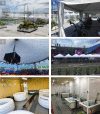IOC consensus statement on recommendations and regulations for sport events in the heat
- PMID: 36150754
- PMCID: PMC9811094
- DOI: 10.1136/bjsports-2022-105942
IOC consensus statement on recommendations and regulations for sport events in the heat
Abstract
This document presents the recommendations developed by the IOC Medical and Scientific Commission and several international federations (IF) on the protection of athletes competing in the heat. It is based on a working group, meetings, field experience and a Delphi process. The first section presents recommendations for event organisers to monitor environmental conditions before and during an event; to provide sufficient ice, shading and cooling; and to work with the IF to remove regulatory and logistical limitations. The second section summarises recommendations that are directly associated with athletes' behaviours, which include the role and methods for heat acclimation; the management of hydration; and adaptation to the warm-up and clothing. The third section explains the specific medical management of exertional heat stroke (EHS) from the field of play triage to the prehospital management in a dedicated heat deck, complementing the usual medical services. The fourth section provides an example for developing an environmental heat risk analysis for sport competitions across all IFs. In summary, while EHS is one of the leading life-threatening conditions for athletes, it is preventable and treatable with the proper risk mitigation and medical response. The protection of athletes competing in the heat involves the close cooperation of the local organising committee, the national and international federations, the athletes and their entourages and the medical team.
Keywords: heat-shock response; hot temperature.
© Author(s) (or their employer(s)) 2023. Re-use permitted under CC BY-NC. No commercial re-use. See rights and permissions. Published by BMJ.
Conflict of interest statement
Competing interests: None declared.
Figures





References
MeSH terms
LinkOut - more resources
Full Text Sources
Miscellaneous
